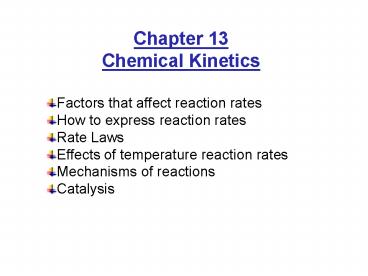Chapter 13 Chemical Kinetics - PowerPoint PPT Presentation
1 / 12
Title:
Chapter 13 Chemical Kinetics
Description:
Chapter 13 Chemical Kinetics Factors that affect reaction rates How to express reaction rates Rate Laws Effects of temperature reaction rates Mechanisms of reactions – PowerPoint PPT presentation
Number of Views:624
Avg rating:3.0/5.0
Title: Chapter 13 Chemical Kinetics
1
Chapter 13Chemical Kinetics
- Factors that affect reaction rates
- How to express reaction rates
- Rate Laws
- Effects of temperature reaction rates
- Mechanisms of reactions
- Catalysis
2
Kinetics
- Studies the rate at which a chemical process
occurs. - Besides information about the speed at which
reactions occur, kinetics also sheds light on the
reaction mechanism (exactly how the reaction
occurs).
3
Factors That Affect Reaction Rates
- Physical State of the Reactants
- In order to react, molecules must come in contact
with each other. The more rapidly reactant
collide with each other, the more rapidly they
react - Most of reactions we consider are homogenous,
involving either gases or liquid solutions
- Concentration of Reactants
- -As the concentration of reactants increases, so
does the likelihood that reactant molecules will
collide.
- Temperature
- At higher temperatures, reactant molecules have
more kinetic energy, move faster, and collide
more often and with greater energy.
- Presence of a Catalyst
- Catalysts speed up reactions by changing the
mechanism of the reaction. - Catalysts are not consumed during the course of
the reaction.
On the molecular level, reaction rates depend on
the frequency of collisions between molecules.
The higher the frequency of collision, the faster
the reaction
4
Reaction Rates
- Reaction rate is the change in concentration of
reactants or products per unit time. Usually
expressed in units of M/s.
Let us consider a hypothetical reaction where
- Rates of reactions can be determined by
monitoring the change in concentration of either
reactants or products as a function of time.
5
An Example
For the time interval between t1 0 sec and t2
20 sec
For the time interval between t1 20 sec and t2
40 sec
Practice Exercise calculate the average rate of
the above reaction over the time interval between
0 and 40 second.
6
Change of Rate with Time
Consider the following actual reaction,
C4H9Cl(aq) H2O(l) ??? C4H9OH(aq) HCl(aq)
Butyl chloride
Butyl alcohol
In this reaction, the concentration of butyl
chloride, C4H9Cl, was measured at various times.
- The average rate of the reaction over each
interval is the change in concentration divided
by the change in time
Average rate -
7
Change of Rate with Time
C4H9Cl(aq) H2O(l) ??? C4H9OH(aq) HCl(aq)
- Note that the average rate decreases as the
reaction proceeds.
- This is because as the reaction goes forward,
concentrations of reactants decrease and
therefore there are fewer collisions between
reactant molecules.
8
Change of Rate with Time
C4H9Cl(aq) H2O(l) ??? C4H9OH(aq) HCl(aq)
- The slope of a line tangent to the curve at any
point is the instantaneous rate at that time.
- All reactions slow down over time. Therefore,
the best indicator of the rate of a reaction is
the instantaneous rate at the beginning, i.e. the
initial rate.
What is the instantaneous rate at t 600 s?
In what follows, the term rate means
instantaneous rate, unless indicated otherwise
What is the instantaneous rate at t 0 s?
9
Reaction Rates and Stoichiometry
C4H9Cl(aq) H2O(l) ??? C4H9OH(aq) HCl(aq)
- In this reaction, the stoichiometric ratio of
C4H9Cl to C4H9OH is 11. - Thus, the rate of disappearance of C4H9Cl is the
same as the rate of appearance of C4H9OH.
What if the stoichiometric ratio is not 11?
2 HI(g) ??? H2(g) I2(g)
For example
2 moles
1 mole
1 mole
Rate of disappearance of HI twice the rate of
production of I2 or H2
Therefore,
10
Reaction Rates and Stoichiometry
- To generalize, then, for the reaction
11
SAMPLE EXERCISE Relating Rates at Which Products
Appear and Reactants Disappear
(a) How is the rate at which ozone disappears
related to the rate at which oxygen appears in
the reaction
(b) If the rate at which O2 appears, ?O2??t, is
6.0 ? 105 M/s at a particular instant, at what
rate is O3 disappearing at this same time,
?O3??t?
12
PRACTICE EXERCISE The decomposition of N2O5
proceeds according to the following equation
If the rate of decomposition of N2O5 at a
particular instant in a reaction vessel is 4.2 ?
107 M/s, what is the rate of appearance of (a)
NO2, (b) O2?
Answers (a) 8.4 ? 10 7 M/s, (b) 2.1 ? 10 7 M/s































